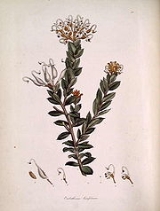
Grevillea buxifolia
Encyclopedia
Grevillea buxifolia is a species of the family Proteaceae
. It grows in coastal New South Wales
, Australia
. First described in 1793 by James Edward Smith
, he gave the new species the name 'Embothrium buxifolium'. It is widely cultivated and contains a numbers of subspecies and cultivars. These vary most in the presentation of the attractive flower.
The species forms a short shrub, three or four feet high. The numerous branches are covered in a reddish or brown hair and many leaves. Flowers sit at the termination of these; yellowish and white, pendulous star shaped petals, set to appear in November.
The flowers of the plant sit alone, erect in umbels, on stalks covered in reddish brown hairs. The corolla is likewise clothed and is partly fused to form a cavity. This interior is white and the petals are otherwise very pale to yellow; this spills above the hairy parts. The single elliptal leaves are veiny, with a very rough dark green upper; margins entire and roll to the downy underside. These are arranged, almost directly to the stem, alternate and numerous up the branches. They end in a little sharp point.
Proteaceae
Proteaceae is a family of flowering plants distributed in the Southern Hemisphere. The family comprises about 80 genera with about 1600 species. Together with the Platanaceae and Nelumbonaceae they make up the order Proteales. Well known genera include Protea, Banksia, Embothrium, Grevillea,...
. It grows in coastal New South Wales
New South Wales
New South Wales is a state of :Australia, located in the east of the country. It is bordered by Queensland, Victoria and South Australia to the north, south and west respectively. To the east, the state is bordered by the Tasman Sea, which forms part of the Pacific Ocean. New South Wales...
, Australia
Australia
Australia , officially the Commonwealth of Australia, is a country in the Southern Hemisphere comprising the mainland of the Australian continent, the island of Tasmania, and numerous smaller islands in the Indian and Pacific Oceans. It is the world's sixth-largest country by total area...
. First described in 1793 by James Edward Smith
James Edward Smith
Sir James Edward Smith was an English botanist and founder of the Linnean Society.Smith was born in Norwich in 1759, the son of a wealthy wool merchant. He displayed a precocious interest in the natural world...
, he gave the new species the name 'Embothrium buxifolium'. It is widely cultivated and contains a numbers of subspecies and cultivars. These vary most in the presentation of the attractive flower.
The species forms a short shrub, three or four feet high. The numerous branches are covered in a reddish or brown hair and many leaves. Flowers sit at the termination of these; yellowish and white, pendulous star shaped petals, set to appear in November.
The flowers of the plant sit alone, erect in umbels, on stalks covered in reddish brown hairs. The corolla is likewise clothed and is partly fused to form a cavity. This interior is white and the petals are otherwise very pale to yellow; this spills above the hairy parts. The single elliptal leaves are veiny, with a very rough dark green upper; margins entire and roll to the downy underside. These are arranged, almost directly to the stem, alternate and numerous up the branches. They end in a little sharp point.

